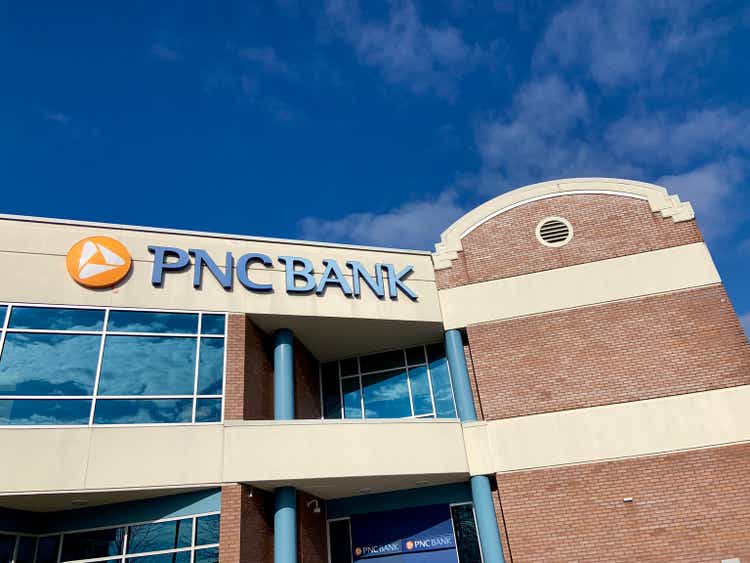bgwalker
I was lukewarm on PNC Financial (NYSE:PNC) back in February, as although I really liked (and still like) management and how they have positioned this bank for durable commercial lending-driven growth, I thought the valuation more or less reflected those qualities. The shares have since modestly underperformed their peers, falling about 25% in a weak market for bank stocks.
Not much surprised me in this quarter, including considerably above-average commercial lending growth and managements relatively more conservative view on the larger economy. With the company still poised to reap long-term benefits from the BBVA deal, as well as this strong lending environment, I think solid mid-single-digit core earnings growth is still in the cards, and with the shares now cheaper, it’s a name worth reconsidering.
Better Core Earnings From PNC, Though Maybe Not As Strong As They Should Have Been
PNC’s overall results for the second quarter were curious in some respects, including a modest miss on net interest income that was more than made up for by stronger fee-based income and better expense control. All told, it was a good quarter underpinned by strong (and strengthening) loan demand, but with some counterbalancing challenges in spread income generation.
Revenue rose 10% year over year and 9% quarter over quarter, beating expectations by about $0.03/share. Net interest income rose 18% yoy and 9% qoq, missing by $0.10/share, as net interest margin (up 21bp you and 22bp qoq to 2.50%) was a little shy of expectations, as were earning assets, despite better-than-expected loan growth. Fee-based income fell 1% yoy and rose 9% qoq, beating by $0.14/share.
Operating expenses rose 10% yoy and more than 2% qoq (on a core basis), and that was good for a $0.07/share beat. Core pre-provision profits rose 10% yoy and over 21% qoq, beating by $0.10/share. Lower provisioning added another $0.25/share relative to the sell-side estimates, while taxes clawed a bit back, leading to a $0.32/share core earnings beat.
Strong Loan Demand, But Funding Is An Emerging Challenge
PNC had a strong quarter from a lending perspective, with loans up almost 6% qoq on an end-of-period basis and close to 5% on an average balance basis – comfortably ahead of the 4% overall loan growth in the broader banking sector.
Commercial lending remained particularly strong, with C&I loans up more than 7% on an average balance basis, almost two points better than the market. Management pointed to stronger utilization rates, as well as loan demand tied to capex investments and working capital (inventory builds), and it looks as though the company gained some share in asset-backed lending.
Consumer lending was weaker, with average balances down almost 1% (several points worse than the average). Auto lending was weak (down 4% qoq) and card lending (up 2% qoq) was lackluster, though mortgage lending was strong (up 6%).
Funding loan growth is starting to emerge as a bigger challenge, and this was something I noted the other day in reference to First Republic (FRC) and its somewhat soft NIM guidance. It’s also something I noted many times about the bank sector in general earlier this year – the risk that deposit betas were going to come in higher than expected as rates increased, leading to higher funding cost (and lower NIMs) than the Street was expecting.
PNC saw low single-digit qoq declines in end-of-period and average deposit balances, as well as year-over-year declines in EOP balances. PNC also saw a 5bp qoq increase in deposit costs and a 10bp qoq increase in total funding costs.
To be clear, PNC is still in good shape relative to most other banks. Even with this higher than expected deposit runoff, the bank still has a good loan/deposit ratio and the ability to fund loan demand. But, management has raised its expectations for deposit beta and noted that it will be paying up to maintain deposit balances, as well as turning more to FHLB borrowings as needed (which cost around 3% or so now).
The Outlook
PNC management has previously mentioned that they expect a recession next year, and given the generally conservative stance of management, that doesn’t really surprise me. How that will impact loan demand remains to be seen (assuming there is a recession), as there are still a lot of industries/companies that have been underinvesting in capacity/capital equipment for some time.
Higher deposit costs and weaker margins don’t really hurt my model where PNC is concerned, as I’d been using higher deposit beta assumptions than many Street analysts. I also like the company’s ongoing leverage to a still very healthy “Main Street” lending/banking environment, and PNC isn’t facing the same capital constraints as some of its larger, more complex rivals.
I’m still expecting strong mid-single-digit (4% to 6%) core earnings growth from PNC over the mid-term and long-term, and I have no real concerns about PNC’s ability to compete for loan share, leverage the synergy opportunities from the BBVA deal, or continue generating excess capital for shareholders. Funding costs are a watch-item, but I think other banks are more vulnerable than PNC. Between my preferred valuation approaches (discounted core earnings, ROTCE-driven P/TBV, and P/E), I believe fair value is in the mid-$180’s today.
The Bottom Line
With the weakness in PNC’s share price, the long-term potential return here is back in the double-digits and relatively attractive. I won’t dismiss the risk that a deteriorating economic outlook for 2023/24 weighs on the shares (and sentiment for banks in general), but I think more long-term oriented investors can consider picking up shares at this level.


Be the first to comment